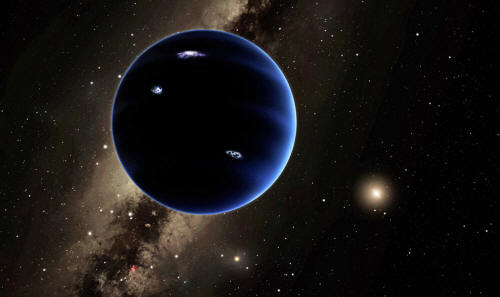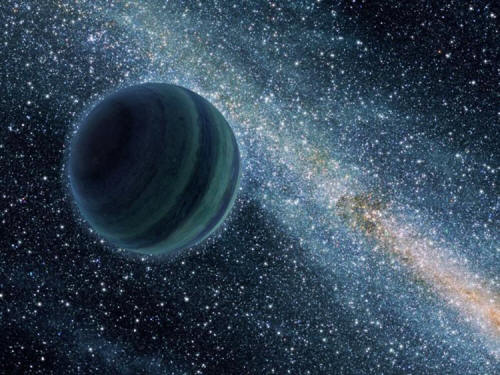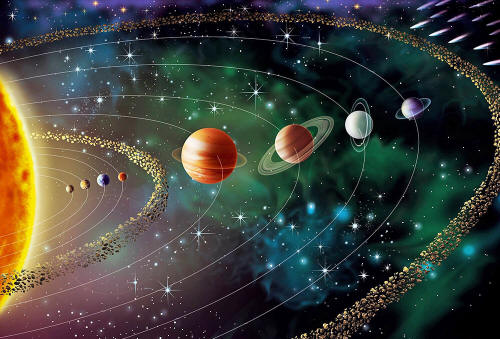|
which may lie
undiscovered in the outer solar system.
An undiscovered planet?
Scott Sheppard performed the new study with Chadwick Trujillo, of the Gemini Observatory in Hawaii.
The two researchers first inferred the possible existence of Planet Nine back in 2014, after analyzing the highly elliptical orbits of the dwarf planet Sedna and a new object they spotted, known as 2012 VP113 (and nicknamed "Biden").
Both bodies inhabit the far outer solar system.
Sedna and 2012 VP113 lie an average of 506 and 259 astronomical units (AU) from the sun, respectively; it takes Sedna about 11,400 Earth years to complete one lap around the sun. (One AU is the average distance from Earth to the sun - about 93 million miles, or 150 million kilometers.)
In their 2014 study, Sheppard and Trujillo noted that Sedna, 2012 VP113 and several other extremely distant objects share certain orbital characteristics, and suggested that these bodies' paths around the sun may have been shaped by a large planet in the region - a world two to 15 times more massive than Earth that lies hundreds of AU from the sun.
This hypothesis was bolstered earlier this year, with the publication of a study (Evidence for a Distant Giant Planet in the Solar System) by astronomers Konstantin Batygin and Mike Brown, both of the California Institute of Technology in Pasadena.
The duo's computer simulations suggested that the gravitational influence of a roughly 10-Earth-mass planet about 600 AU from the sun could indeed explain the odd "clustering" in the orbits of Sedna, 2012 VP113 and a handful of other distant objects.
The sample size of such putatively affected bodies has always been small, but it's getting bigger.
Illustration of the orbits of newfound and previously known extremely distant solar system objects. The clustering of most of their orbits indicates that they are likely being influenced by something massive and very distant - the proposed Planet Nine, also known as Planet X. Credit: Courtesy of Robin Dienel
The evidence mounts
For the past few years, Sheppard, Trujillo and David Tholen of the University of Hawaii have been hunting for objects in the far outer solar system using several different instruments, including the Subaru Telescope in Hawaii and the Dark Energy Camera, which is installed on a 4-meter telescope at the Cerro Tololo Inter-American Observatory in Chile.
The new study (Beyond the Kuiper Belt Edge - New High Perihelion Trans-Neptunian Objects with Moderate Semimajor Axes and Eccentricities), which has been accepted for publication in The Astronomical Journal, reports this survey's latest finds.
The astronomers discovered several dozen previously unknown bodies, including a roughly 155-mile-wide (250 km) object called 2013 FE72 that gets an incredible 4,000 AU from the sun at its most distant point.
That puts it out in the outer Oort Cloud - the realm of comets.
They also discovered two 125-mile-wide (200 km) objects, known as 2014 SR349 and 2013 FT28, that "cluster" in one of the key orbital parameters (known as argument of perihelion), furthering strengthening the case for Planet Nine's existence.
(The objects' names reflect the years that they were first spotted in the survey; their discovery is being announced in the new study.)
Furthermore, he added, the five most distant of these 15 extreme objects share similarities in another orbital characteristic as well, one called longitude of perihelion.
Significantly, the far-flung five are too distant to be realistically affected by any gravitational tugs from Neptune (whose influence could be the reason the other 10 objects' longitudes of perihelion don't line up).
It would take just two or three more such additional finds to put Planet Nine on solid ground, Sheppard said.
Getting a look at Planet Nine?
Finding Planet Nine via a blind search would be incredibly difficult and time-consuming.
The putative world, while big, would also be quite faint because of its immense distance from the sun. The planet's huge and as-yet-undetermined orbital path also means it could be hiding anywhere along a large swath of sky.
But Brown has said that Planet Nine may well be visible through powerful telescopes, provided astronomers point them in the right direction at the right time.
And the ongoing survey Sheppard and his colleagues are performing should help researchers do that.
- Several Never Before Seen
Objects Discovered Extremely Far Away from Our Sun -
Something is out there, but what is it?
The quest for mythical Planet X or Planet 9, as astronomer call the object continues. Many theories have been put forward, but Planet 9 refuses to give up its secrets and be found.
Some astronomers say it doesn't it.
Others have suggested Planet 9 was actually
stolen by our Sun about 4.5 billion years ago.
new and previously known extremely distant Solar System objects. The clustering of most of their orbits indicates that they are likely be influenced by something massive and very distant,
the proposed Planet
X.
The objects are called trans-Neptunian
because their orbits around the Sun are greater than Neptune's.
This lead them to predict that there is a planet at more than 200 times our distance from the Sun.
Its mass, ranging in possibility from
several Earths to a Neptune equivalent, is shepherding these smaller
objects into similar types of orbits.
Analysis of "neighboring" small body orbits suggest that it is several times more massive than Earth, possibly as much as 15 times more so, and at the closest point of its extremely stretched, oblong orbit it is at least 200 times farther away from the Sun than Earth. (This is over 5 times more distant than Pluto.)
According to Sheppard,
The new objects they have submitted to the Minor Planet Center for designation include 2014 SR349, which adds to the class of the rare extreme trans-Neptunian objects.
It exhibits similar orbital
characteristics to the previously known extreme bodies whose
positions and movements led Sheppard and Trujillo to initially
propose the influence of Planet X.
The orbit of an object is defined by six parameters. The clustering of several of these parameters is the main argument for a ninth planet to exist in the outer solar system.
2013 FT28 shows similar clustering in
some of these parameters (its semi-major axis, eccentricity,
inclination, and argument of perihelion angle, for angle enthusiasts
out there) but one of these parameters, an angle called the
longitude of perihelion, is different from that of the other extreme
objects, which makes that particular clustering trend less strong.
It has an orbit that takes the object so far away from the Sun (some 3000 times farther than Earth) that it is likely being influenced by forces of gravity from beyond our Solar System such as other stars and the galactic tide.
It is the first object observed at such a large distance...
|





